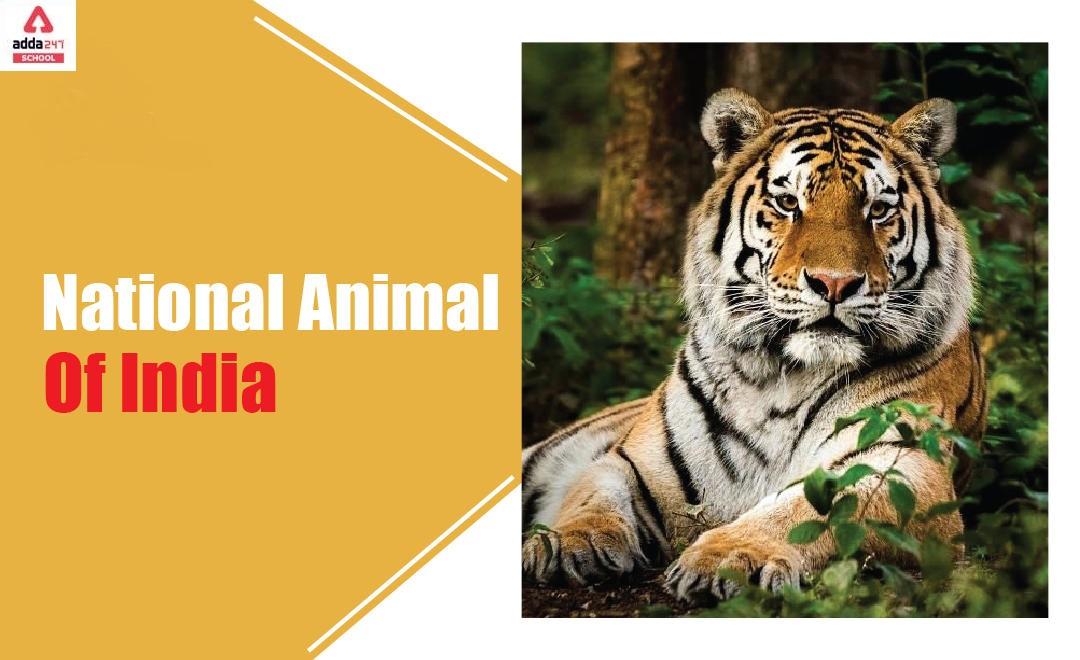National Animal of India
The national animal of India is the Bengal Tiger, scientifically known as Panthera tigris tigris. The Bengal Tiger is a symbol of strength, agility, and grace and holds significant cultural and ecological importance in India. National Animal of India Tiger was declared the national animal of India in 1972 to highlight the need for the conservation and protection of this majestic species, which is native to the Indian subcontinent.
Indian National Animal
Countries have national symbols, which represent the significance of that particular symbol as well as symbolise a certain motto or quality. It is a known fact that like other country’s national symbols, India’s national symbols represent the country’s image and had been carefully selected to do so, as it is a known fact that the country and its ethnic culture are defined by its national emblems. The Royal Bengal Tiger is India’s national animal.
Apart from its significance in mythologies, India is home to 80 per cent of the world’s tigers. The Royal Bengal Tiger has even appeared on Indian banknotes and postage stamps in India.
In this article, we will be providing you with comprehensive information on Indian national animal, the Royal Bengal Tiger.
India’s National Animal Classification
India’s National Animal Classification is given below table.
| Kingdom | Animalia |
| Phylum | Chordata |
| Clade | Synapsida |
| Class | Mammalia |
| Order | Carnivora |
| Family | Felidae |
| Genus | Panthera |
| Species | Panthera tigris |
| Subspecies | Panthera tigris tigris |
National Animal of India Tiger
The magnificent Royal Bengal Tiger, which is a population of the Panthera tigris Tigris subspecies and ranks among the largest wild cats alive today, is India’s national animal. It is a striped mammal with a thick yellow coat of fur with dark stripes that are regarded to be part of the world’s charismatic megafauna.
The tiger is one of the most distinguished carnivores among the Indian fauna, having been present in the Indian subcontinent from the Late Pleistocene, for around 12,000 to 16,500 years. It is stately, regal, and lethal all at the same time. Today, however, it is endangered due to poaching, habitat loss, and fragmentation. By 2011, it was predicted that there were fewer than 2,500 wild individuals left, and none of the Tiger Conservation Landscapes within its range are large enough to support a population of more than 250 adults.
Until the early nineteenth century, the Bengal tiger’s historical range spanned almost all of India and into Pakistan’s Indus River valley, but it today only exists in India, Bangladesh, Nepal, Bhutan, and southern Tibet.
National Animal of India Before Tiger
The National Animal of India before Tiger was Lion. Three separate mitochondrial nucleotide locations and 12 unique microsatellite alleles distinguish the Bengal tiger, and the pattern of genetic diversity in the Bengal tiger supports the theory that it arrived in India around 12,000 years ago. This explains why there are no tiger fossils from the Indian subcontinent before the late Pleistocene.
Bengal tigers have a yellow to light orange coat. Stripes range in colour from dark brown to black. The tail is orange with black rings, while the belly and inside regions of the limbs are white. Although the white tiger is a recessive mutation, it is not albinism.
The average total length of males and females is 270 to 310 cm and 240 to 265 cm, respectively. A tail of 85 to 110 cm in length is included in the average total length. Furthermore, they are normally 90 to 110 centimetres tall, with males weighing 175 to 260 kilogrammes and females weighing 100 to 160 kilogrammes. The tiger’s teeth are extraordinarily strong, with canines ranging in length from 7.5 to 10 cm and a skull length of 332 to 376 mm.
The national animal of India, the Royal Bengal Tiger can be found primarily in Grasslands and dry scrubland (Ranthambore in Rajasthan), Rainforests in the tropics and subtropics (Corbett in Uttarakhand/Periyar in Kerala), Mangroves(Sunderbans) and Kanha in Madhya Pradesh and Simlipal in Odisha, that have both wet and dry deciduous forests.
In the wild, a Bengal tiger has an average lifespan of 8 to 10 years, with a maximum lifespan of around 15 years. In the wild, very few tigers live to be 15, as they grow too weak to hunt huge animals, while Bengal tigers can live up to 18 or 20 years in captivity.
नेशनल एनिमल
देशों में राष्ट्रीय प्रतीक होते हैं, जो उस विशेष प्रतीक के महत्व का प्रतिनिधित्व करते हैं और साथ ही एक निश्चित आदर्श वाक्य या गुणवत्ता का प्रतीक हैं। यह एक ज्ञात तथ्य है कि अन्य देश के राष्ट्रीय प्रतीकों की तरह, भारत के राष्ट्रीय प्रतीक देश की छवि का प्रतिनिधित्व करते हैं और ऐसा करने के लिए सावधानी से चुने गए थे, क्योंकि यह एक ज्ञात तथ्य है कि देश और इसकी जातीय संस्कृति को इसके राष्ट्रीय प्रतीकों द्वारा परिभाषित किया गया है। रॉयल बंगाल टाइगर भारत का राष्ट्रीय पशु है।
पौराणिक कथाओं में इसके महत्व के अलावा, भारत दुनिया के 80 प्रतिशत बाघों का घर है। रॉयल बंगाल टाइगर भारत में भारतीय बैंक नोटों और डाक टिकटों पर भी दिखाई दिया है।
Which is the National Animal of india in Hindi?
शानदार रॉयल बंगाल टाइगर, जो कि पैंथेरा टाइग्रिस टाइग्रिस उप-प्रजाति की आबादी है और आज जीवित सबसे बड़ी जंगली बिल्लियों में शुमार है, भारत का राष्ट्रीय पशु है। यह एक धारीदार स्तनपायी है जिसमें गहरे पीले रंग की धारियों के साथ फर का एक मोटा कोट होता है जिसे दुनिया के करिश्माई मेगाफौना का हिस्सा माना जाता है।
बाघ भारतीय जीवों में सबसे प्रतिष्ठित मांसाहारियों में से एक है, जो भारतीय उपमहाद्वीप में लेट प्लीस्टोसिन से लगभग 12,000 से 16,500 वर्षों तक मौजूद रहा है। यह एक ही समय में आलीशान, शाही और घातक है। आज, हालांकि, यह अवैध शिकार, आवास के नुकसान और विखंडन के कारण संकटग्रस्त है। 2011 तक, यह भविष्यवाणी की गई थी कि 2,500 से कम जंगली व्यक्ति बचे थे, और इसकी सीमा के भीतर कोई भी बाघ संरक्षण परिदृश्य 250 से अधिक वयस्कों की आबादी का समर्थन करने के लिए पर्याप्त नहीं है।
उन्नीसवीं शताब्दी की शुरुआत तक, बंगाल टाइगर की ऐतिहासिक सीमा लगभग पूरे भारत और पाकिस्तान की सिंधु नदी घाटी में फैली हुई थी, लेकिन आज यह केवल भारत, बांग्लादेश, नेपाल, भूटान और दक्षिणी तिब्बत में मौजूद है।
National Animal of India in Hindi
तीन अलग-अलग माइटोकॉन्ड्रियल न्यूक्लियोटाइड स्थान और 12 अद्वितीय माइक्रोसेटेलाइट एलील बंगाल टाइगर को अलग करते हैं, और बंगाल टाइगर में आनुवंशिक विविधता का पैटर्न इस सिद्धांत का समर्थन करता है कि यह लगभग 12,000 साल पहले भारत आया था। यह बताता है कि प्लीस्टोसिन के अंत से पहले भारतीय उपमहाद्वीप से बाघ के जीवाश्म क्यों नहीं हैं।
बंगाल के बाघों का कोट पीले से हल्के नारंगी रंग का होता है। धारियों का रंग गहरे भूरे से काले रंग तक होता है। पूंछ काले छल्ले के साथ नारंगी है, जबकि पेट और अंगों के अंदर के क्षेत्र सफेद हैं। हालांकि सफेद बाघ एक बार-बार होने वाला उत्परिवर्तन है, लेकिन यह ऐल्बिनिज़म नहीं है।
पुरुषों और महिलाओं की औसत लंबाई क्रमशः 270 से 310 सेमी और 240 से 265 सेमी है। औसत कुल लंबाई में 85 से 110 सेमी लंबाई की पूंछ शामिल होती है। इसके अलावा, वे आम तौर पर 90 से 110 सेंटीमीटर लंबे होते हैं, पुरुषों का वजन 175 से 260 किलोग्राम और महिलाओं का वजन 100 से 160 किलोग्राम होता है। बाघ के दांत असाधारण रूप से मजबूत होते हैं, जिसमें कुत्ते की लंबाई 7.5 से 10 सेमी और खोपड़ी की लंबाई 332 से 376 मिमी तक होती है।
भारत का राष्ट्रीय पशु, रॉयल बंगाल टाइगर मुख्य रूप से घास के मैदानों और शुष्क झाड़ियों (राजस्थान में रणथंभौर), उष्णकटिबंधीय और उपोष्णकटिबंधीय क्षेत्रों में वर्षावन (उत्तराखंड में कॉर्बेट / केरल में पेरियार), मैंग्रोव (सुंदरबन) और मध्य प्रदेश में कान्हा में पाया जा सकता है। और ओडिशा में सिमलीपाल, जिसमें गीले और सूखे दोनों पर्णपाती वन हैं।
जंगली में, एक बंगाल टाइगर का औसत जीवन काल 8 से 10 वर्ष होता है, अधिकतम जीवन काल लगभग 15 वर्ष होता है। जंगली में, बहुत कम बाघ 15 साल तक जीवित रहते हैं, क्योंकि वे बड़े जानवरों का शिकार करने के लिए बहुत कमजोर हो जाते हैं, जबकि बंगाल के बाघ कैद में 18 या 20 साल तक जीवित रह सकते हैं।
List of National Animals of India and all other Countries
| Country |
National Animal
|
| Afghanistan |
Marco Polo Sheep
|
| Argentina | Puma |
| Australia | Kangaroo |
| Bangladesh |
Royal Bengal Tiger
|
| Belgium | Lion |
| Bhutan | Takin |
| Bolivia | Llama |
| Brazil | Jaguar |
| Bulgaria | Lion |
| Chile | Huemul |
| China |
Chinese Dragon
|
| Colombia |
Andean Condor
|
| Cuba |
Cuban Crocodile
|
| Cyprus | mouflon sheep |
| Denmark | Lion |
| Egypt | Saladin’s Eagle |
| England | Lion, Bulldog |
| Finland | Brown Bear |
| France | Gallic Rooster |
| Hungary | Turul |
| India |
Royal Bengal Tiger
|
| Iraq |
Komodo Dragon
|
| Ireland |
Irish Wolfhound, Red Deer
|
| Israel | gazelle |
| Japan | Pheasant, Koi |
| Jordan | Oryx |
| Malaysia | Malayan Tiger |
| Myanmar | peafowl |
| Netherlands | Lion |
| New Zealand | Moose |
| Norway | Lion |
| Pakistan | Markhor |
| Philippines | Carabao |
| Poland | White Eagle |
| Portugal | Iberian wolf |
| Puerto Rico | Coqui |
| Romania | lynx |
| Russia |
Russian Brown Bear
|
| Scotland |
Unicorn and Lion
|
| Singapore | Lion |
| South Africa |
Springbok Antelope
|
| South Korea | Korean Tiger |
| Spain | Bull |
| Sri Lanka | Lion |
| Taiwan |
Formosan Black Bear
|
| Thailand | Thai Elephant |
| United States of America |
American Bison
|
| Vietnam | Water Buffalo |
| Zimbabwe | Sable Antelope |
Related Post:









 BTEUP Result 2025 Out at bteup.ac.in, Do...
BTEUP Result 2025 Out at bteup.ac.in, Do...
 SGBAU Result 2025 Out, Check Summer Seme...
SGBAU Result 2025 Out, Check Summer Seme...
 How To Prepare for CUET Accountancy Exam...
How To Prepare for CUET Accountancy Exam...









